Aim for the Ace!
(Ace wo Nerae!)

Note: "bestanime.com" stole
the above scan from our site here and labelled it as being Ace TV-1 1973. However, it is from Ace Final Stage
OAV 1988. Bestanime.com gets our vote for "sleaziest anime review site."
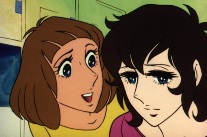
|
| Hiromi (R) with best friend Maki (L), from TV series 1, 1973
|
General Comments
In Japan, this anime is on everyone's list of
most-loved classic animes of their youth. Despite its age, the
story is timeless in its charm. The anime is based on the
early 70's manga by Sumika Yamamoto,
which appeared in Margaret magazine. This is a sports anime, and
nearly every conflict and issue ends up leading to the tennis court.
But ultimately, it is personal relationships and spiritual growth which
directs this story, not simply the issue of winning or losing.
There are two TV series, plus a movie, and two OAV
series, all of them done by the Dezaki/Sugino team. We have started at
the beginning, with the 1973 TV series 1. We have 76 episodes to do:
51 from TV and 25 from OAV's, plus a movie. Strangely, this count is
exactly the same as "Marmalade Boy". Maybe that's a good omen.
However, "Ace" doesn't have a lot in common with the light romantic comedy
in "Marmalade Boy."
An Early "Oniisama E"?
Fans of "Brother Dear Brother" (BDB)
will find several similarities in the plot. Hiromi is only a rookie tennis player,
yet the coach chooses her to be on the team defending the club's title,
a position desired by many other players. Did the coach see special
talent in Hiromi, or was there some other, deeper reason? In this
sense, Hiromi is in the identical position that Nanako found herself in. Like
Nanako, Hiromi
must endure the disdain of her fellow club members while doing her best
to keep up with requirements of her new position. Her best friend stands by
her, helping her hold on and not quit. When either Hiromi or Nanako get depressed,
they climb up into their school's clock tower and sit there alone. All of this
will sound somewhat familiar to the BDB fan. However, 20
years, a whole generation gap, separate Hiromi's story from the much-later Nanako in BDB.
Osamu Dezaki and Akio Sugino probably regard "Ace" as a work of their youth.
Many fans of BDB love the dark atmosphere of menace and twisted passion
that pervades the series. Do we see more of the same
in "Ace"? A bit, but "Ace" doesn't go as far as BDB in this respect.
The series starts out on a somewhat lighthearted note for the first volume.
As it goes on, the humorous parts fall into the
background more and more, and drama becomes predominant. You see Hiromi mature and become stronger due to
facing stress and sorrow. Part of the theme is how positive determination can
prevail over negativity and shallowness.
As with most shoujo animes, there's a mascot. This one is Goemon, a cat.
He is a
fairly silly cat, and Hiromi plays with him a lot. In volume 1, silly humor
is only seen during a few short scenes where the cat is being a little daffy.
The rest of the humor is character humor, in which we can chuckle at someone's
naivete, or someone's typical overreaction, or someone's typical personality
flaw, etc. Nowhere in volume 1 do we have a truly chilling moment like BDB fans
saw in BDB vol. 1. [Remember in BDB, volume 1, Nanako ascends the clock tower to find
Saint Juste throwing knives at an outline scrawled on the wall.] Instead, we have
Hiromi facing personal challenges and interpersonal conflict. Her reactions
are somewhat immature in volume 1, but again, keep in mind that this is an
epic, and she changes with time. By the time we get to Ace Final, she's a
young woman who is stronger and more mature, and so the atmosphere of the anime
changes to reflect that. However, the anime never reaches the "darkness" we
saw in BDB. In that respect, perhaps no other shoujo anime can really
ever outdo BDB. If you're looking for an anime that is "like BDB" in that way,
you won't find anything quite that intense. But Ace is wonderful in other
respects. You probably have NEVER seen colors used so richly as in volume 1
of Ace. If you like color, you get a chance to see what happens when Akio
Sugino, Dezaki's brilliant partner who does all chara design and art direction,
goes crazy. The pinks, oranges, and magentas are stunning. The purple
shadows are everywhere. The landscapes look like they are lit by the light
crew at a rock concert. Ace can't ever replace BDB, but perhaps you'll someday also feel that BDB
can't ever replace Ace, too. Both are something really special.
 Our Fansub of Eps. 1-4
Our Fansub of Eps. 1-4
Hiromi Oka, a freshman at Nishi High School, idolizes
glamorous and charismatic Reika Ryuuzaki, the school's tennis team star, and
joins the tennis club to be near her. However, a mysterious new coach arrives.
He unexpectedly chooses Hiromi to be on the school's varsity
tennis team instead of veteran player Kyoko Otowa. Hiromi, a
complete beginner at tennis, finds she must now compete at a match only a few days away.
Meanwhile, Kyoko Otowa feels strongly that she
should have been chosen instead, and begins a campaign to discredit
Hiromi. In addition, Hiromi's classmates are confused and
upset, and take it out on Hiromi, who begins looking for a way out.
When she tries to quit the team,
her resignation is refused without explanation.
She is in a state of near-panic when the day of the match arrives.
Why did the coach choose her? What hope does she have against a vastly
more experienced opponent? The "Ace" story begins!
A Quick Look at the Artwork and Characters
(from TV series 1, 1973)
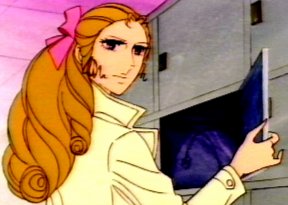
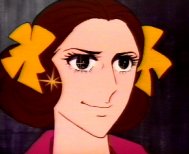
Hiromi (above) is the main character.
Unlike a lot of the other characters in the anime, her hair style is modest
and no-frills, almost pixie-ish. The tall, elegant student
(Reika Ryuzaki, aka "Ochofujin", right) is certainly a prototype of "Miya-sama" of
"Brother, Dear Brother". (Remember that this anime is from 1973,
preceding both the Dezaki/Sugino anime "Oniisama He" and the 1975 manga
by Riyoko Ikeda from which it was derived.) Ryuzaki is idolized
by the other students. And of course, no BDB fan can fail to
"recognize" the scheming Aya Misaki, or at least her 20-years earlier prototype,
Kyoko Otowa, in this anime! (left)
(Below) Hiromi trapped
in "Tennis Hell"
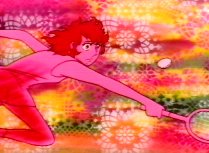
Ryuzaki ("Ochofujin") like an angel
(or more accurately, a butterfly)
in "A Garden of Tennis", below
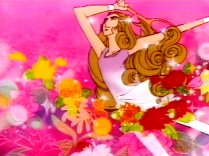 "Op" ga Ippai!
"Op" ga Ippai!
Master animator and character designer Akio Sugino
uses the most inventive effects of light, background, and juxtaposition
you are likely to ever see in anime. Here we see two emotional moods
expressed stylistically -- first, Hiromi feels like she is trapped in a
confusing hell in which she cannot connect with the ball. Then we
see Ryuzaki flying through a paradise of flowers and butterflies, every
move of her racquet a masterstroke of athletic prowess. In addition
to still concepts like these, there are also elaborate fades and dissolves,
and superpositions of images, often with dynamic backgrounds which pulsate
with emotion or glitter with beauty. The Op-Art movement of the late
60's and early 70's clearly influence the artwork, with all its psychedelic
and eye-dazzling effects, and the color scheme bursts with yellow, pink,
and electric magenta. Yet the overall concept probably isn't derived
directly from the Warhol/Beatles movement, and close examination shows
this Dezaki/Sugino series to be more like a "hip" modernization of some of the techniques seen
in shoujo manga of the day. Especially surprising are some of the
backgrounds, in which persons who aren't speaking are sometimes rendered
as neutrally-colored silhouettes only -- a very "manga" technique which
we saw only a trace of in "Rose of Versailles" and not at all in "Brother
Dear Brother."
Despite lovely effects like these, the overall animation
quality is limited, probably by both budget and time, giving a more simplistic
anime style. Don't forget, this was done way back in the early
70's. Expect a presentation with some things in common with, say,
"Urusei Yatsura." "Brother Dear Brother" fans should expect a slightly
more "basic" approach to the art style, though the viewer's eye quickly
adapts, and the style quickly seems to look less unfamiliar as time goes
on. In fact, the unique stylism quickly becomes lovely to the eye,
and the silhouettes and outlines soon are a virtue completely their own, making
one wish that the days of enhanced realism in anime had not pushed aside such
compromises.
However, the graphics certainly isn't really
a step backward -- for instance, I would
say that the quality of the cell painting in "Ace" is superior to that
in "Brother Dear Brother." Only the limited-bandwidth monaural soundtrack
can be said for sure to be an unwelcome drawback of this feature's age.
Below: Hiromi, from OAV series 1

News
Our translator for "Ace wo Nerae!" is Manami Kudo.
We're very happy she has agreed to work on this project with us. By the way,
this was our 2nd fansub to be 100% digitally mastered. For additional
information on our digital mastering method, see our
"equipment" section.
(No, this is not a digital fansub you can download. A digitally mastered tape is
one which has the captions added in a computer instead of with a genlock. Our
master for volume 1 of Ace is a set of 8 files totalling about 4 Gigabytes, encoded
in Mpeg2. This is equivalent to a homemade DVD.)
It took a couple of years, but we did succeed in
obtaining all four seasons of "Ace wo Nerae". Most of it had to be
purchased as used merchandise from private parties in Japan, though TMS did do a limited
release of season 1 on DVD recently. The new DVD set is described as a "new mastering."
The new DVD's certainly have improved resolution and color purity over
the original LD's, but they show the effects of the aging original source
more than the LD set, with "brown outs" on some damaged frames. Despite the
problems, we decided to use the DVD version for our fansub. With regard
to season 2, we were not able to locate the LD set, which is very rare, but
a dear friend is going to loan us his set. Here is the
current status of our worldwide search for original source video:
The Source Video
|
"Ace wo Nerae!" TV season 1, 1973, eps. 1-26, 26 eps total: We have the
complete LD set and the newer (but imperfect) DVD set. We chose to use the DVD
set as the source video for the season 1 fansubs.
"Shin Ace wo Nerae" TV series 2 (season 2), 1978-79, eps. 27-51, 25 eps total: a close friend in Hooseki owns the laserdisk set and promises that we can use them.
This set is the rarest of the lot. It showed on NTV. Like the earlier series, it was made by TMS.
"Ace wo Nerae Movie: "Theatrical Version" (original name) or
"Jump High Hiromi!" (name in the rental market) (1979,
re-released in 1987): we have this on LD.
"Ace wo Nerae 2" OAV series 1 (season 3), (1988) eps. 52-64, 13 eps total: we have all on original commercial
tapes.
"Ace wo Nerae Final Stage" OAV series 2 (season 4), 1988-89, eps. 65-76, 12 eps total: we have the complete
set of season 4 on LD. We also have eps. 65-68 on commercial tapes.
|
Note: the above
information has been verified by careful research. Unfortunately, the Internet is full of erroneous and
incomplete information about the number of episodes and other details of the Ace
original series. This is partially due to European repackaging of Ace episodes
for showing locally, and then European sites drawing the wrong conclusions about
the series content. (In Europe, the first season, 26 eps, was carved and reformatted into
30 pieces for showing.) Also, some of the series (especially "Shin Ace") were
re-run on TV in Japan more than once, each time with a different number of episodes.
However, the "extra" episodes were probably "summary" or "compilation"
episodes containing no new material. The above episode count reflects only
the episodes in the original runs, excluding redundant material.
Below: original dogeared Ace manga.
(Pic from a public auction in Japan.)

Personal comments
By the way, the similarity between "Ace wo Nerae 2" and
"Oniisama He" is absolutely staggering. Miya-sama, for instance,
IS Ryuzaki-san. Not "looks like" but "is". My jaw hit the
floor when I watched. The "Tomoko" character is there too, named "Maki", with a different
hair style, and an "Aya Misaki" (Kyoko Otowa). I simply couldn't believe it. Akio
Sugino must have carried the character design of "Ace 2" and "Ace Final" DIRECTLY to
"Oniisama He". In fact, I now believe that one of the
key reasons for "Oniisama He" was to continue, on NHK,
the "Ace" tradition and look (though not the story) for
desperate fans of the Ace series, without infringing on
copyrights. This definitely was a revelation. I knew the
similarity with series 1 was considerable, but I wasn't
prepared for this.
Sponsorships are available for 2 episodes still: 6 and 7.
Sponsorships are $50 each.
Note: that unlike some subtitlers, Technogirls sponsorships never include any
tapes, master or otherwise -- sponsorships are pure donations. All Ace sponsorships go to
help pay the translator. Sponsors who wish to receive a copy of the completed fansub can
make separate arrangements by email, if they like. There are two sponsors for
episode 1 and 1 sponsor per episode after that.
Sponsors :
( 1) "The Cinderella of the Tennis World"
sponsored by Joe W. and Joshua R.
( 2) "You're the One!"
sponsored by Joe W.
( 3) "Tearful Chiku Match"
sponsored by Rosa Carmona.
( 4) "Showdown on the Tennis Court"
sponsored by The DEIMOZ Project.
( 5) "Conflict with the Oni-Coach"
sponsored by M.R. Scorpion
( 6) (No title yet)
sponsored by Chris Reed & the Anime Raiders
( 7) (No title yet)
sponsored by Mike K.
( 8) (No title yet)
sponsored by The DEIMOZ Project
This page was designed in a generic text editor and checked in Explorer 5,
Netscape 4, and Opera 5. Last updated on 12/18/2001.










































































































































































